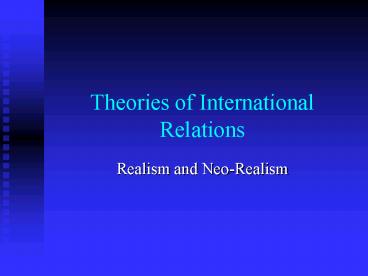Theories of International Relations PowerPoint PPT Presentation
1 / 14
Title: Theories of International Relations
1
Theories of International Relations
- Realism and Neo-Realism
2
Learning Objectives
- Why do students of international relations rely
on theory? - Differences between theories, opinions, and other
sources of social knowledge - Principles of Realism and Neo-realism
3
Key Terms
- Anarchy
- Balance of power
- Paradigm
- Rationality
- Self-help
- Theory
4
What are Theories?
- Logically coherent explanations of some
phenomenon or phenomena. - Make predictions about future
- Differ from authority, tradition, common sense,
personal experience, opinion - Derive from paradigms
5
Realism
- Realism has been the dominant theory of world
politics since the beginning of the academic
study of International Relations. - Roots of Realism can be traced to the work of
people such as Thucydides, Hobbes, and
Machiavelli all of whom were skeptical about the
capacity of human reason to deliver moral
progress.
6
What Unites Realists? Overview
- The unifying theme around which all realist
thinking converges is that states find themselves
operating in an anarchic realm that places their
security constantly at risk. - States respond to this situation by competing for
power and security. - It is rational for states to self-help.
7
What Unites Realists Survival
- The primary objective of all states is survival.
- This is the supreme national interest to which
all political leaders must adhere. - All other goals such as economic prosperity are
secondary (or low politics). - In order to preserve the security of their state,
leaders must use ends-means calculations.
8
What Unites Realists Self-help
- No other state or institution can be relied upon
to guarantee survival. - Coexistence is achieved through the balance of
power.
9
What Divides Realists?
- Human nature vs. Anarchy
- Are states prone to violence because people are
fundamentally flawed or because the nature of the
world creates incentives for violence?
10
Neo-realism
- New Realism focuses on the structural causes of
war and competition. - Anarchy promotes competition and war, not
friendship, trust, and honor - Absence of global government generates
uncertainty. - Opportunities for cooperation are limited.
11
The World as Prisoners Dilemma
12
Offensive and Defensive Realists
- Structural realism divides into two camps
- Offensive realists states are power maximizers
- Defensive realists States are security maximizers
13
Criticisms of Realism
- Self-help is not an inevitable consequence of the
absence of a world government. - Self-help is a logic that states have selected.
- Some states prefer collective security in
preference to self-help. - Non-state organizations and multi-national
corporations are increasingly powerful in the
modern world.
14
Criticisms of Realism cont.
- Balances of power are not inevitable.
- Unclear why states have not moved to balance
against the power of the United States. - The survival motive may not be universal.

